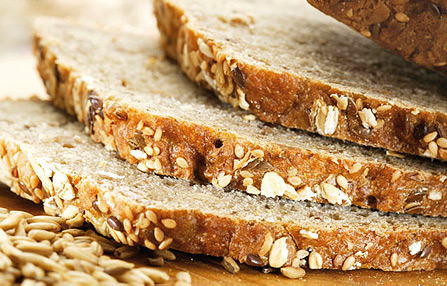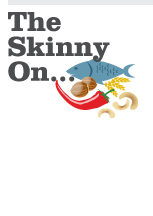The Skinny on... Bread
From doughy white slices to the crustiest artisanal loaf, here’s what to look for when buying the staff of life.


Who hasn’t heard that bread is fattening? Some people would have you believe that eating a slice is akin to downing an entire birthday cake, frosting and all. But in reality, if you stick to whole grains, bread can be downright healthy. Here’s a guide to navigating the bread aisle.
The whole-grain shebang
Whole grains — for example, wheat flour milled using the entire grain, which preserves all the fiber, vitamins and minerals — have multiple health benefits. According to the USDA, people who consume at least three servings of whole grains each day are at lower risk for diabetes and heart disease. And several studies have shown that diets high in whole grains are associated with lower body weight.
What to look for at the store
The supermarket bread aisle overflows with options. Our advice: Read packages carefully. Ingredients are listed in proportional order, so if the first item doesn’t begin with the word “whole,” beware. Even if it’s the second or third item, the amount may not be substantial.
Multigrain breads are trickier, since each individual grain is only a small portion of the recipe, but taken all together the whole-grain content may be superb. Other whole grains you might see include barley, brown rice, buckwheat, bulgur (cracked wheat), corn, millet, oats, rye and spelt. Ideally, you’re looking for 16 grams of whole grains in a serving — most bread that meets this level will mention it somewhere on the package. This advice works across the board for sliced bread, English muffins, bagels, wraps — you name it.
What to avoid
When you’re reading the label, steer clear of breads with predominantly “white flour,” “enriched white flour” or “wheat flour” — all three terms signify that the grain has been refined: stripped of the nutrient- and fiber-rich bran and germ. All you’re getting here is the starchy stuff, with none of the health benefits. Also look at what kind of fats are listed, and avoid trans fats (partially hydrogenated, vegetable oil shortening or hydrogenated vegetable oil). These are the fats that can increase your risk for heart disease. None of them are essential in bread-baking, so they’re easy to dodge.
At the bakery
Without a package to read, it’s difficult to know for sure exactly what you’re getting with bakery bread. But there are some rules of thumb: Look for whole-wheat bread. Ask if you can pick up the loaf before buying, and if it’s lighter than air, don’t buy it. Generally speaking, the heftier the bread, the higher the whole-grain content. And don’t be afraid to ask questions! Bakers are often proud to discuss their product and will be more than happy to tout high-quality ingredients.
The whole-grain shebang
Whole grains — for example, wheat flour milled using the entire grain, which preserves all the fiber, vitamins and minerals — have multiple health benefits. According to the USDA, people who consume at least three servings of whole grains each day are at lower risk for diabetes and heart disease. And several studies have shown that diets high in whole grains are associated with lower body weight.
More Bread-Aisle Food for Thought
Whole white wheat
If you (or your kids) don’t like the hearty taste of whole-grain breads, this option uses an albino variety of the grain, which is not only lighter in color but also milder in flavor. Double-check that you’re buyingwhole white wheat, though, or you may wind up with refined flour, which offers very little nutritional value.
Light breads
Choosing bread isn’t only about whole grains; carbs, protein, fat and fiber should be taken into account too. Light whole-grain breads can save calories while still offering fiber to keep you feeling satisfied, which is one reason why they're Weight Watchers Power Foods. A single slice of one brand’s 100-percent whole-wheat bread has aPointsPlus™value of 2, and you’ll get two slices of their light variety for the same number of PointsPlus values. Double the fun!
Organic breads
More a question of overall health benefits than dietary ones. The ingredients are grown without pesticides, herbicides or fungicides, which may be beneficial to your body and the planet, but won’t make much difference nutritionally.
If you (or your kids) don’t like the hearty taste of whole-grain breads, this option uses an albino variety of the grain, which is not only lighter in color but also milder in flavor. Double-check that you’re buyingwhole white wheat, though, or you may wind up with refined flour, which offers very little nutritional value.
Light breads
Choosing bread isn’t only about whole grains; carbs, protein, fat and fiber should be taken into account too. Light whole-grain breads can save calories while still offering fiber to keep you feeling satisfied, which is one reason why they're Weight Watchers Power Foods. A single slice of one brand’s 100-percent whole-wheat bread has aPointsPlus™value of 2, and you’ll get two slices of their light variety for the same number of PointsPlus values. Double the fun!
Organic breads
More a question of overall health benefits than dietary ones. The ingredients are grown without pesticides, herbicides or fungicides, which may be beneficial to your body and the planet, but won’t make much difference nutritionally.
The supermarket bread aisle overflows with options. Our advice: Read packages carefully. Ingredients are listed in proportional order, so if the first item doesn’t begin with the word “whole,” beware. Even if it’s the second or third item, the amount may not be substantial.
Multigrain breads are trickier, since each individual grain is only a small portion of the recipe, but taken all together the whole-grain content may be superb. Other whole grains you might see include barley, brown rice, buckwheat, bulgur (cracked wheat), corn, millet, oats, rye and spelt. Ideally, you’re looking for 16 grams of whole grains in a serving — most bread that meets this level will mention it somewhere on the package. This advice works across the board for sliced bread, English muffins, bagels, wraps — you name it.
What to avoid
When you’re reading the label, steer clear of breads with predominantly “white flour,” “enriched white flour” or “wheat flour” — all three terms signify that the grain has been refined: stripped of the nutrient- and fiber-rich bran and germ. All you’re getting here is the starchy stuff, with none of the health benefits. Also look at what kind of fats are listed, and avoid trans fats (partially hydrogenated, vegetable oil shortening or hydrogenated vegetable oil). These are the fats that can increase your risk for heart disease. None of them are essential in bread-baking, so they’re easy to dodge.
At the bakery
Without a package to read, it’s difficult to know for sure exactly what you’re getting with bakery bread. But there are some rules of thumb: Look for whole-wheat bread. Ask if you can pick up the loaf before buying, and if it’s lighter than air, don’t buy it. Generally speaking, the heftier the bread, the higher the whole-grain content. And don’t be afraid to ask questions! Bakers are often proud to discuss their product and will be more than happy to tout high-quality ingredients.




No comments:
Post a Comment